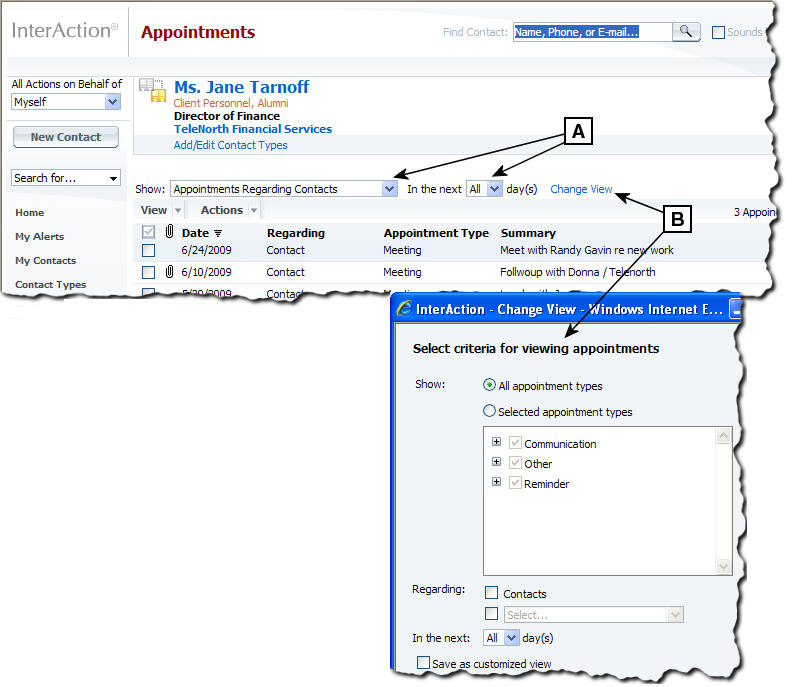Section Topics
Using Appointments in the Web Client
In InterAction, appointments are future-dated meetings entered into Microsoft Outlook as calendar items and synchronized with InterAction. You use Outlook to choose which appointments you want synchronized with InterAction.
Within the Web Client, you can view and search for the appointments that have been added to InterAction. Appointments are also displayed on your My Alerts page. For details, see Monitoring Your Contacts for Alerts.
Note that the appointment features in InterAction are optional; your organization may choose not to use them.
See the following topics:
- View Appointments for a Contact
- View Your Upcoming Appointments
- What Happens to Appointments in InterAction after they take place?
View Appointments for a Contact
The Appointments section of the overview page displays appointments for the contact. From here you can also open the full-page appointments page.
In addition, there are several searches you can use to find appointments. You can find appointments for contacts, matters, opportunities, and engagements. You can also search based on other criteria. For details, see Finding Activities and Appointments.
When viewing appointments for a contact, you can filter the view to display just the appointments you need.

Filtering Your Appointments View
[A] This appointments filter only shows appointments that are regarding contacts.
[B] Choose Change View to filter the list based on a variety of criteria.
Filter the Appointments View
-
Display the contact overview page or the appointments page for a contact.
-
Choose the Change View link.
-
Select the criteria for the appointments you want to view.
You can filter the appointments by a variety of criteria:
-
Appointment type. The available types are organized into groups.
-
Regarding. If your organization has licensed a related module, you can include activities regarding matters, opportunities, or engagements.
-
Time frame. You can select a date range, such as In the next 30 days.
-
-
Choose OK. The view is filtered according to your options.
Print the Appointments
You can print reports for any list of appointments. You can also print individual appointments one at a time. For details, see Viewing and Printing Activity and Appointment Reports.
View Your Upcoming Appointments
You can use the My Upcoming Appointments link to display all appointments that meet the following criteria:
- You are either the originator or a contact included on the activity or appointment.
- The item uses one of the appointment types, such as “Meeting.” Note that both activities and appointments can use these types.
- Date is today or later.
Do the following:
-
From the Search For drop-down list in the left-hand menu, choose Appointments.
-
Choose General appointment search.
-
Under the View Lists section, choose My upcoming appointments.

Your appointments are displayed in a list.
-
If you want to change the criteria used to find the appointments, choose Change Search. Make your changes and choose OK.
What Happens to Appointments in InterAction after they take place?
After the date for an appointment has taken place, the appointment is converted to an InterAction activity. This lets you maintain the history of your interactions with the contact on an ongoing basis.
Note that for a while after the conversion, the activity continues to synchronize with Microsoft Outlook. You can update the Outlook version of the appointment with meeting notes or other changes, and the InterAction version (the activity) is updated with those changes. Also, if you update the original PIM appointment to a future date (for example, if the original meeting was rescheduled to a future time), the meeting is converted back to an appointment after synchronization.
The amount of time an activity that used to be an appointment continues to synchronize is determined by your system administrator.
Also note that you can edit the activity in InterAction during this time. Doing so breaks the connection between the activity in InterAction and the appointment in Outlook. Any future updates to the Outlook version are not updated in InterAction in this case. Before breaking the connection, the Web Client displays a warning message. This is a sample of the message displayed when using Microsoft Outlook:

